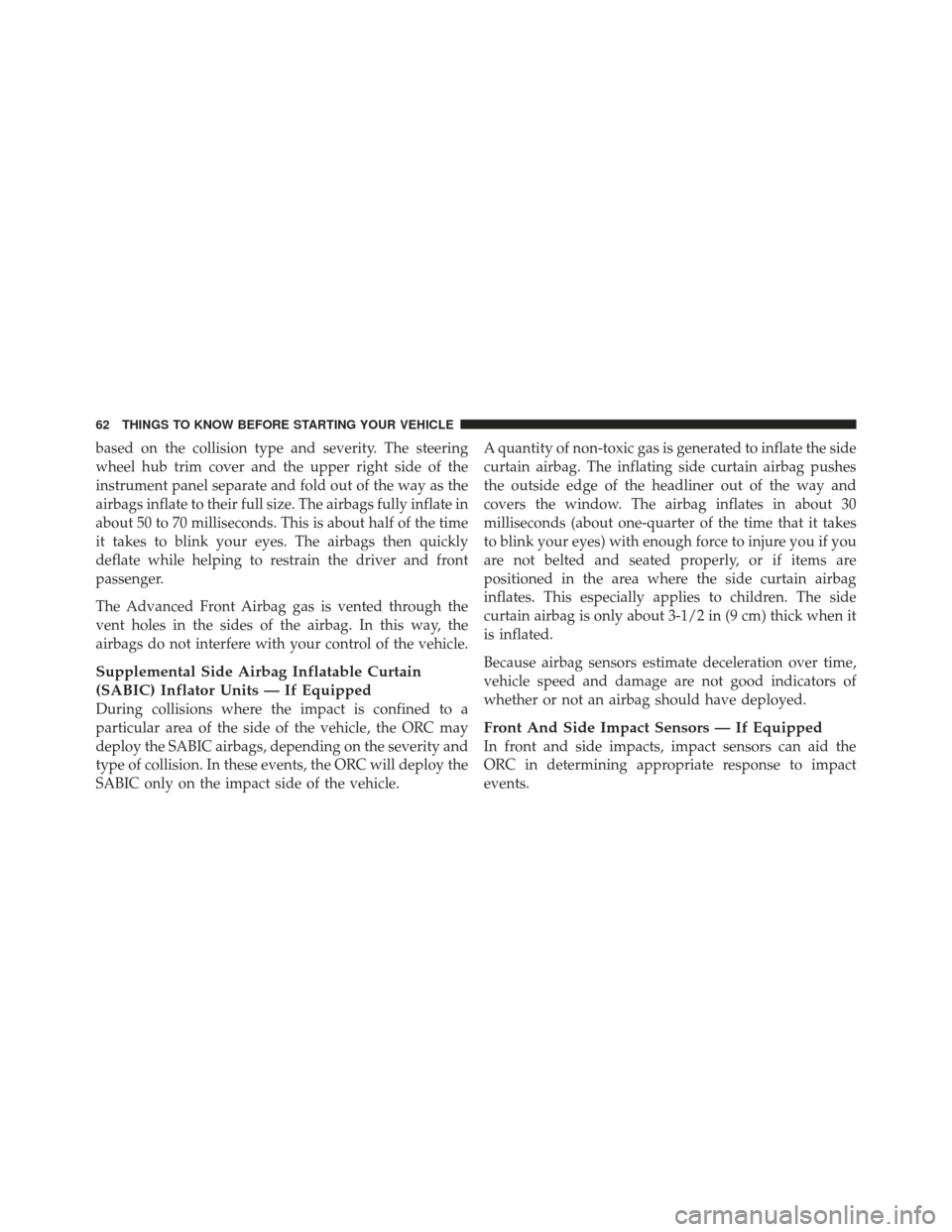Page 64 of 636

based on the collision type and severity. The steering
wheel hub trim cover and the upper right side of the
instrument panel separate and fold out of the way as the
airbags inflate to their full size. The airbags fully inflate in
about 50 to 70 milliseconds. This is about half of the time
it takes to blink your eyes. The airbags then quickly
deflate while helping to restrain the driver and front
passenger.
The Advanced Front Airbag gas is vented through the
vent holes in the sides of the airbag. In this way, the
airbags do not interfere with your control of the vehicle.
Supplemental Side Airbag Inflatable Curtain
(SABIC) Inflator Units — If Equipped
During collisions where the impact is confined to a
particular area of the side of the vehicle, the ORC may
deploy the SABIC airbags, depending on the severity and
type of collision. In these events, the ORC will deploy the
SABIC only on the impact side of the vehicle.A quantity of non-toxic gas is generated to inflate the side
curtain airbag. The inflating side curtain airbag pushes
the outside edge of the headliner out of the way and
covers the window. The airbag inflates in about 30
milliseconds (about one-quarter of the time that it takes
to blink your eyes) with enough force to injure you if you
are not belted and seated properly, or if items are
positioned in the area where the side curtain airbag
inflates. This especially applies to children. The side
curtain airbag is only about 3-1/2 in (9 cm) thick when it
is inflated.
Because airbag sensors estimate deceleration over time,
vehicle speed and damage are not good indicators of
whether or not an airbag should have deployed.
Front And Side Impact Sensors — If Equipped
In front and side impacts, impact sensors can aid the
ORC in determining appropriate response to impact
events.
62 THINGS TO KNOW BEFORE STARTING YOUR VEHICLE
Page 451 of 636
Ethanol Fuel (E-85)
E-85 is a mixture of approximately 85% fuel ethanol and
15% unleaded gasoline.
WARNING!
Ethanol vapors are extremely flammable and could
cause serious personal injury. Never have any smok-
ing materials lit in or near the vehicle when remov-
ing the fuel filler tube cap (gas cap) or filling the
tank. Do not use E-85 as a cleaning agent and never
use it near an open flame.
Fuel Requirements
Your vehicle will operate on both unleaded gasoline with
an octane rating of 87, or E-85 fuel, or any mixture of
these two. For best results, a refueling pattern that
alternates between E-85 and unleaded gasoline should be
avoided.
When you do switch fuel types it is recommended that:
•you do not switch when the fuel gauge indicates less
than 1/4 full
E-85 Badge
5
STARTING AND OPERATING 449
Page 552 of 636

•Do not overfill the coolant recovery bottle.
•Check engine coolant (antifreeze) freeze point in the
radiator and in the coolant recovery bottle. If engine
coolant (antifreeze) needs to be added, contents of
coolant recovery bottle must also be protected against
freezing.
•If frequent engine coolant (antifreeze) additions are
required, or if the level in the coolant recovery bottle
does not drop when the engine cools, the cooling
system should be pressure tested for leaks.
•Maintain engine coolant (antifreeze) concentration at
50% HOAT engine coolant (antifreeze) (minimum)
and distilled water for proper corrosion protection of
your engine, which contains aluminum components.
•Make sure that the radiator and coolant recovery
bottle overflow hoses are not kinked or obstructed.
•Keep the front of the radiator clean. If your vehicle is
equipped with air conditioning, keep the front of the
condenser clean, also.
•Do not change the thermostat for Summer or Winter
operation. If replacement is ever necessary, install
ONLY the correct type thermostat. Other designs may
result in unsatisfactory engine coolant (antifreeze)
performance, poor gas mileage, and increased
emissions.
Brake System
In order to assure brake system performance, all brake
system components should be inspected periodically.
Refer to the “Maintenance Schedule” for the proper
maintenance intervals.
550 MAINTAINING YOUR VEHICLE
Page 565 of 636

To help maintain the appearance of your Spray-On
Bedliner, the manufacturer recommends you periodically
rinse all loose dirt from your truck bed and clean your
truck at least twice per year using the MOPAR�
Spray-On Bedliner Conditioner available at your local
authorized dealer.
To help maintain the appearance of your Spray-On
Bedliner, follow the steps below:
1. Rinse your truck bed out with water to remove any
loose dirt and debris.
2. Mix a mild soap or detergent with water with a soft
cloth or brush.
3. Rinse bedliner with water.
4. Once dry, apply a small amount of MOPAR�
Spray-On Bedliner Conditioner to a moist towel or
sponge and wipe over the entire surface of the truck
bedliner.WARNING!
Do not use silicon-based protection products to clean
your bedliner. Silicon-based products can become
slippery and may result in personal injury.
Spray-On Bedliners are chemically-resistant to many
different types of chemicals (including gasoline, oil,
hydraulic fluids) for short periods of time. If a spill
occurs on your Spray-On Bedliner, rinse the truck out as
soon as possible to avoid permanent damage.
Repairing the Spray-On Bedliner
While extremely tough, it is possible to damage a
Spray-On Bedliner. One common condition is when
loading a heavy pallet and dragging that pallet across the
floor of the bed. If a nail or sharp point is exposed under
the weight of the pallet a scratch or tear is possible. While
not covered by your new vehicle warranty, a cosmetic fix
7
MAINTAINING YOUR VEHICLE 563